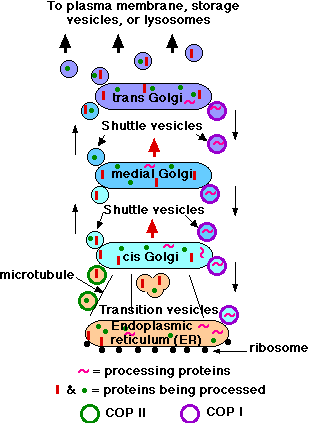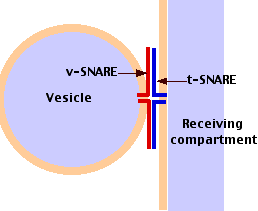
 |
| In this cell (from a bat), the Golgi apparatus (boxed in red) is used for the final stages in the synthesis of proteins that are to be secreted from the cell. (Courtesy of Keith R. Porter.) |
| Link to discussion of the paths taken by proteins when they leave the Golgi. |
Example: proopiomelanocortin (POMC) — a polypeptide of 241 amino acids from which is cut
The Golgi consists of a stack of membrane-bound cisternae located between the endoplasmic reticulum and the cell surface.
 Many different enzymes (proteins) are present in the Golgi to perform its various synthetic activities. So there must be mechanisms
Many different enzymes (proteins) are present in the Golgi to perform its various synthetic activities. So there must be mechanisms
Two mechanisms appear to participate in the migration of proteins from the endoplasmic reticulum through the Golgi apparatus.
Mechanism 1.
Mechanism 2.
In addition to the pinching off and fusing of shuttle vesicles, the cisternae of the Golgi actually migrate themselves; that is, the cis Golgi gradually migrates up the stack becoming a medial and finally a trans Golgi (depicted in the figure with red arrows).
The movement of cisternal contents through the stack means that essential processing enzymes are also moving away from their proper site of action.
Using a variety of signals, the Golgi separates the products from the processing enzymes that made them and returns the enzymes back to the endoplasmic reticulum.
This transport is also done by pinching off vesicles, but the inbound vesicles are coated with COPI (coat protein I)
 This involves pairs of complementary integral membrane proteins
This involves pairs of complementary integral membrane proteins
v-SNAREs and t-SNAREs bind specifically to each other thanks to the complementary structure of their surface domains.
Binding is followed by fusion of the two membranes.
| Welcome&Next Search |